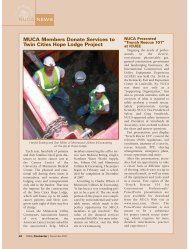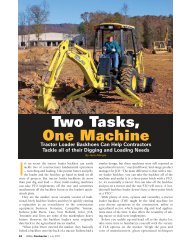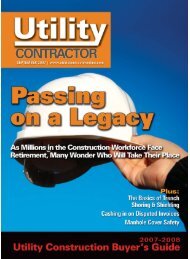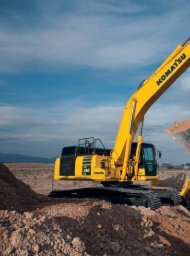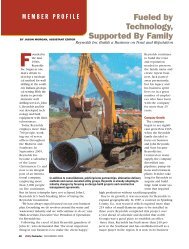View Full May PDF Issue - Utility Contractor Online
View Full May PDF Issue - Utility Contractor Online
View Full May PDF Issue - Utility Contractor Online
You also want an ePaper? Increase the reach of your titles
YUMPU automatically turns print PDFs into web optimized ePapers that Google loves.
Mapping the Market<br />
Finding the Light in Economic Gloom<br />
By Mitch Blake<br />
The North American wheel loader market consisting of<br />
new units sold in Canada and the United States was<br />
approximately 14,600 units in 2008. By comparison,<br />
roughly 20,000 units were sold in 2006. The primary<br />
markets that 75 percent of all wheel loaders are sold are road<br />
and bridge construction, rental, residential construction, commercial<br />
construction and agriculture.<br />
All of the primary markets have been affected by the recent<br />
economic downturn, except for the agriculture market,<br />
which has seen a 14 percent increase in wheel loader sales<br />
since 2006. While many wheel loader markets are experiencing<br />
a decline in sales, not all markets are being dramatically<br />
affected by the current economic conditions. In addition to<br />
the agriculture market, the scrap/recycling market has been<br />
steadily growing since 2006.<br />
Within most of the markets, there exists a variety of purchasers.<br />
To generalize these purchasers, they are typically<br />
either a commercial contractor or a government end-user<br />
(states, municipalities, airports, etc.). For the most part, government<br />
purchasing has remained steady in the market segments.<br />
Considering most market segments are in a decline,<br />
the commercial purchasers have contributed the most to the<br />
wheel loader industry sales decline. This is not surprising in<br />
that construction as a whole has experienced a major downturn<br />
and appropriation of funds for government purchases<br />
primarily come from taxes received from prior years.<br />
Even within a particular market, the purchasing actions of<br />
the specific segments to that market can vary dramatically. One<br />
example is the rental market. The rental market is made up of<br />
two segments: independent rental companies and OEM dealer<br />
rental fleets. It is interesting to observe that since 2006, the<br />
independent rental companies have reduced their wheel loader<br />
purchases in North America by 73 percent while OEM dealers<br />
have reduced their rental fleet purchases by only 30 percent.<br />
The wheel loader is a versatile and widely used piece of heavy<br />
equipment within North America. It is a mature product with<br />
contractors and government users who are comfortable with its<br />
uses in their specific applications. Generally, there haven’t been<br />
many new applications for wheel loaders in recent years, but<br />
the wheel loader can be tasked in varying applications by region.<br />
For example, where many regions may use an excavator to<br />
dig a basement, some areas of North America regularly see this<br />
task being undertaken by a wheel loader. While recent economic<br />
downturns have noticeably affected the construction industry,<br />
one can be rest assured that the wheel loader will be seen in the<br />
building sites, streets, highways and landscape of North America<br />
well into the future.<br />
Mitch Blake is the Brand Marketing Manager for Case Construction<br />
Equipment, Racine, Wisc.<br />
Riddle 1:<br />
Large as a mammoth, small for close quarters,<br />
predestined cycles are the usual orders.<br />
Digging makes the day move slow,<br />
so you’ll burden me with loads on the go.<br />
I eat with my teeth or sometimes a fork,<br />
but my meal is finished when you’re done with work.<br />
<strong>May</strong> 2009 | <strong>Utility</strong> <strong>Contractor</strong> 19




